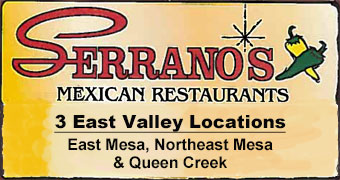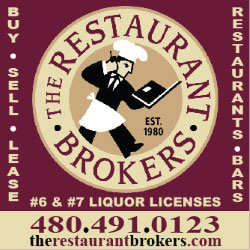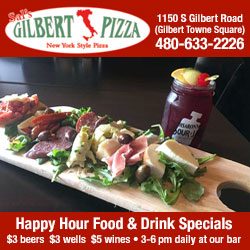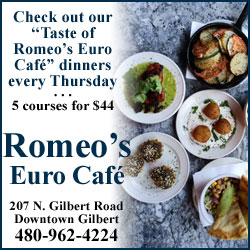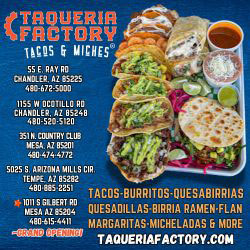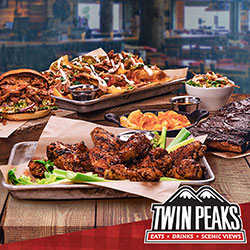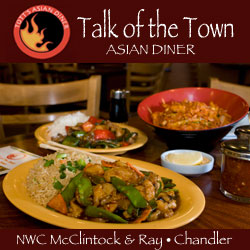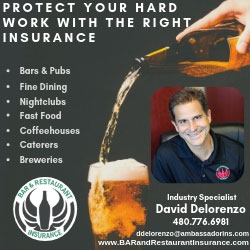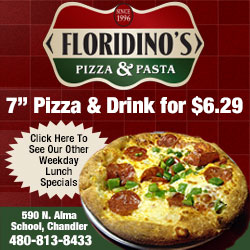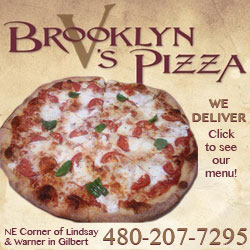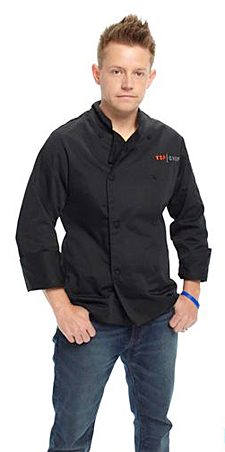 (Editor’s note: Congratulations to Richard Blais, who won Bravo’s “Top Chef All-Stars” Wednesday night. To celebrate his victory, we dug up our extensive interview with Blais from July 2008, a month after his loss to Scottsdale Culinary Institute grad Stephanie Izard in the “Top Chef” Season 4 finale. Midway through the interview Blais mentions how he’d like to get another chance to appear on “Top Chef” and redeem himself. Well, chef, mission accomplished.)
(Editor’s note: Congratulations to Richard Blais, who won Bravo’s “Top Chef All-Stars” Wednesday night. To celebrate his victory, we dug up our extensive interview with Blais from July 2008, a month after his loss to Scottsdale Culinary Institute grad Stephanie Izard in the “Top Chef” Season 4 finale. Midway through the interview Blais mentions how he’d like to get another chance to appear on “Top Chef” and redeem himself. Well, chef, mission accomplished.)
Since his second-place finish on Bravo’s reality television show “Top Chef†last month, Richard Blais has been a busy man. He’s welcomed his first child, daughter Riley Maddox, and opened a new restaurant, Home, in his home city of Atlanta. He’s also consulting on a new gourmet burger restaurant called Flip that will open in September.
The fauxhawk-sporting 36-year-old is working on deals for a book and a TV show that would feature his creative cooking style, a cross between a mad chemist and MacGuyver — think liquid nitrogen and smoke guns — that’s been labeled “molecular gastronomy.â€
Blais also is working on product innovation with companies ranging from Garrett popcorn to Red Stripe beer. And this Saturday, he will participate in “Top Chef: The Tour†when it comes to the Valley for three interactive shows.
I caught up with Blais by telephone as he was on his way to his Atlanta restaurant.
Your culinary career seems to be blowing up right now. What did you really want to be when you grew up?
I wanted to be a professional athlete, in particular a baseball player. No one ever told me until I was a senior in high school that I really didn’t run that fast and that I was a little shorter than most athletes. But I definitely wanted to be an athlete, and that kinda carried over into my cooking career. I really enjoy the camaraderie of working as a team in the kitchen.
People refer to you as a molecular gastronomist or gadget guy. Is that an oversimplification of what you do?
People refer to me as that, but I don’t. I’m a creative chef. I think what we do is art. It’s kinda unfortunate that people do label what I do as molecular gastronomy or gadget cooking or whatever. Everyone’s got gadgets. It’s a profession that obviously relies on tools. So finding new tools or researching new ways to use tools that already exist or, in the case of something like the nitrogen, going to find a tool that’s used in some other artistic medium and bringing it to the kitchen — I think that’s pretty neat. But I hate when people say it’s all about the gadgets. At the end of the day, it’s all about flavor and it’s about food. It’s pretty impossible for us to take a bad tomato and make it better with any tool or any application of molecular gastronomy.
What would be a more accurate description of your culinary style?
Creative. A creative chef — I hate to say modern — who uses modern techniques. Why I’m excited about going to Phoenix is that I’ve never been there before so I don’t know what the market’s going to have. I may think I know what’s going to be there, but I don’t. I’m sure I’m going to see a couple ingredients I’ve never seen before. I think every chef needs to be regional wherever they’re cooking.
I heard your first job was at McDonald’s. What did you learn?
And it might be my next job – who knows! What I learned was the giant structure of an organization like McDonald’s. I really love brands. If I find a brand, I really stick to it. McDonald’s is a great brand. It’s an American classic. It’s almost iconic. And what I learned is what makes that. What makes people go to the golden arches or go to Starbucks every day? Those are things, especially for someone that puts himself out on the edge and does creative things, at the end of the day I’d love people to come to my restaurant like they go to McDonald’s or Starbucks.
Speaking of McDonald’s, what is your favorite junk food?
I’d go with a hamburger, if you can consider that a junk food. I love cheeseburgers. Cheeseburgers and fries and milkshakes — it’s kinda hard to go wrong with. Now that I’m thinking about it, some fried fish might be nice. I’m not sure these are necessarily junk foods. I’m always a sucker for a chocolate bar, too.
I hear you’re consulting on a gourmet burger concept called Flip that’s opening this fall. What’s the key to a great burger?
You’re the first person to ask me this question, but it’s one we’ve often asked ourselves inside our own think tank for the project. To me, it’s the balance between the amount of the meat to amount of the bun and the amount of the condiment. It sounds simple but I think a lot of times, especially when chefs start conceptualizing hamburgers, it becomes about the organic meat and what type of meat — and that’s very important. But most important thing is that textural difference between the bun and the meat and the toppings. It’s gotta have that cold versus hot. It’s gotta have soft versus crunch. We’re not gonna come out and put a 12-ounce burger on a little bun, which a lot of chefs do to make it a “restaurant burger.†That’s what makes a Whopper a great burger. It’s not that it’s the best meat you’ve ever had. It’s not that the bread’s freshly baked. It’s that “Wow, there’s just the perfect amount of mayonnaise versus tomato versus onion versus meat!â€
You had a restaurant called Blais that offered a 31-course tasting menu. Was there an actual philosophy behind that many courses?
That was in my younger days, probably about four years ago. I’ve stepped away from doing that many courses. But the first key is making sure the food is small. Like I said, I love cheeseburgers and I love steak, but I don’t like walking away from a meal feeling like, “Wow, I’m gonna have to work out twice as hard the next day†or just feeling so heavy I have to go to sleep. So the first key is making sure it’s light enough and, almost in a healthy way, making sure you’re staying away from certain fats and starches that really give people the perception of being full. Then there’s a progression from lighter tastes to heavier or stronger flavors. But also, inside that progression, there’s one or two pit stops like, “OK, this is a very acidic course†or “It’s very citrus-y,†just to kinda start all over again and stay away from palate fatigue. So there is a philosophy. It gets harder once you get over 10 courses to sit there and say, “Why are we going to serve this course after that course?†But you can still do it.
You’ve competed on both “Iron Chef†— narrowly losing to Mario Batali — and “Top Chef.†If you had opportunity to go back and do one of them again, or be on one of them again in future, which would it be?
Wow, that’s interesting. This is the first time someone’s aked me that. I think the way “Iron Chef†is set up is to be almost like a boxing match, where it’s easier or more acceptable for contestants to come back. I wouldn’t turn down either opportunity if it came back again. They were both great opportunities. In all honesty, “Top Chef†is much more grueling. It’s the difference between a marathon and a sprint. But as far as what has happened from my appearance on “Top Chef,†I would love to go back and do that again because, even with things not working out 100 percent the way I wish they would have, the doors that have opened are amazing.
Has the rise of all the food-related TV shows, as well as magazines and Internet sites, affected chefs? Has style become as important as skill?
As great as it’s been, there’s also been a bit of negative side, for sure. I was classically trained. My TV shows were, like, Julia Childs. I didn’t grow up with Emeril, just to use it as an example. I trained in a classical French system and then fell in love with creative cooking. And then I realized, “Wait, this might be cool. I’m gonna go on TV.†It kind of just happened, but it happened through training and working as a restaurant chef. I do think there’s a lot of young people who go to culinary school now, or decide they want to be chefs, because they’re watching a TV show. They don’t necessarily understand the 15-hour days or the nine or 10 years it’s gonna take to get yourself in the situation to even be on a television show. So that’s the one little downside of it. I have interns that work with me that come into my restaurant and I say, “Why do you want to be here?†And they say, “I want to be a molecular gastronomist.†You know, I don’t have a position for them. What I want people to say is, “I want to cook tasty food and I want to learn how to cook great.†We’ll get to the other stuff down the road.
With all the user-review sites like Chowhound and Yelp, do you and other chefs today feel constantly under scrutiny?
As great as it is for the information that everyone can have, the downside is that there are people who come into my restaurant that think they are critics. They think they are as knowledgeable as someone who has trained and is writing for the New York Times. They’ll go home and post a three-page report on a half-an-hour meal or whatever it is like they’re writing for a major publication. I don’t think it’s really been controlled. There is that possibility that someone could come in here, or anyone’s restaurant, and not really know what they’re talking about and for some reason think they didn’t have a very good experience and then trash the place. All of a sudden, it’s sitting out there every time you Google “Richard Blais.†Enough other chefs — Mario Batali and Tony Bourdain — have spoken out against these blogging sites. The flip side is that they’re amazing resources for information. I’d be dishonest not to say I’ll probably check out one of these sites when I head to Phoenix to see what’s going on in the area. So it’s kind of a double-edged sword.
Here in the Valley, we occasionally see well-regarded restaurants that unexpectedly close. You youself have had a couple of acclaimed restaurants in Atlanta close after less than a year.
That’s the thing. From a business perspective, it’s a lot tougher than people think. We’re selling something that only lasts, basically, for a couple of days. I like break it down to my interns: If we buy a piece of fish and we don’t sell all of it today, we don’t have a clearance rack. We can’t put it in the back of the restaurant up on a shelf for two months and eventually we’ll sell it. The perish-ability of what we do is just crazy, and the higher up you go — this is why fine dining is taking such a hit — the more labor that’s involved. It’s a tough business model. (Pauses) I just realized the answer, if you want to give any chefs the answer to how to fill a restaurant up: Go on a national television show. I appreciate that. I know what it feels like to empty a restaurant out to get four or five stars. The television show, at least for me, really validated creative food. People are coming into my restaurant now saying, “Can I have some tofu-flavored beef?†or “Are you selling bacon ice cream tonight?†These were the types of items people were not coming to my restaurant specifically for, so I’m personally really blessed to have gone on the show.
So there’s an inherent tension between great food and a sustainable business model?
Being edgy in our field is tough. If you talk about super-creative restaurants in the United States, there aren’t that many of them. I’m not gonna name any names, but I’m in New York every other week right now and I’ve eaten at some of the most creative ones. At 8:30 on a Thursday night, I’ve been in an empty restaurant that has four stars, that has great reviews, that everyone would put on their list of five, six creative restaurants probably in the world, and these restaurants aren’t busy. It’s not because they’re too expensive. It’s not because the dining room isn’t pretty. It‘s not because there’s bad service, and it’s not because they don’t have tasty food. It’s because they’re doing something that’s a little bit different. The show (“Top Chefâ€), and the TV show I’m trying to make happen — there are bigger reasons than me just going on TV and having a good time. I really think mass media and television are opportunities to really expand some of these restaurants and make this creative food movement grow.
Then is Atlanta the right city for you? Would your style be more accepted in a New York or San Francisco?
It’s a tough question to answer as I’m walking around the parking lot of my restaurant here. I’m a New Yorker originally. I’m into college football, and a lot of college football coaches will have that one clause in their contract that’s like, “Here’s my contract, but if this one school comes calling, all bets are off.†I lived in San Francisco and I’m a New Yorker, and I love those two cities. And I love Atlanta because it’s put me on the map and there are so many people here that are great. Is it a place I can see three or four really creative restaurants surviving over a long period of time? Probably not. Just in general, if you think about the South, it takes them a long time to embrace things not as crazy as bacon ice cream, you know? Historically, it took the South a long time to embrace the civil rights movement, for example. So we’ll see where it goes. The difference is that Atlanta is a big metropolitan city and the South is almost disconnected from that. You know what I mean? I live in Atlanta. I don’t feel like I live in Georgia.
What culinary trends right now do you really embrace?
The big trend I embrace right now is molecular mixology, bringing the kitchen to the bar. I’m doing a lot of work with some corporate beverage companies, and I think you’re gonna see more of the things I do, whether it’s liquid nitrogen or the smoke — the textural manipulation of food I think you’re gonna see really come to the forefront on the bar scene. For example, my work with liquid nitrogen. I can freeze alcohol, something that most people I’ve done seminars for — that even work for alcohol companies — will raise their hands and say, “You can’t freeze alcohol.†I’ll pull out a tank of liquid nitrogen and all of a sudden we’re making gin-flavored ice cubes. That’s one example. Think about walking on the beach in Miami eating a mojito popsicle, or to be able to do interactive tequila shots at a club that just sorta pop themselves out of a machine. These are just some of the kinds of things we’ve demonstrated. I think you’ll see molecular gastronomy go into the bar first and become mainstream before you see it go into the kitchen mainstream. At the end of the day, people still just want to get a good buzz off of a nice drink. The creativity inside a glass is a little bit easier embraced by the masses.
What culinary trends do you wish would just die?
The trend of chefs saying that their restaurant is about getting the best ingredients from local farms. That should be every chef’s goal. When it becomes a spiel for a restaurant, I get kinda upset about that. It doesn’t matter if you open up a hamburger restaurant or a French restaurant or an Asian restaurant or whatever, every good chef’s goal should be to get the best ingredients, locally sourced, right from the ground. With being green such a giant trend in general, I think you’re gonna see this still go on and it’s just silly to me. It should always be the goal of any great chef.
Beside the book and the TV show and the new restaurants, do you have anything else on the horizon?
Subscribe to the free MXSW Daily Email here for the latest news about food & drink in the Phoenix metro area.Well, that’s a lot. I gotta go check my e-mail — maybe there’s something else out there. That’s kinda how it’s been happening. Every day a new door opens up. I don’t know what’s next after the things we discussed, but I’ll be cooking, that’s for sure, and we’ll looking out over the edge and thinking about whether or not to jump.

